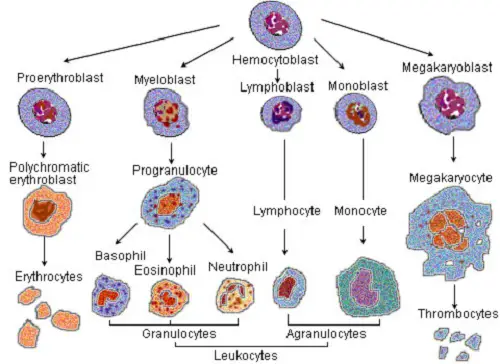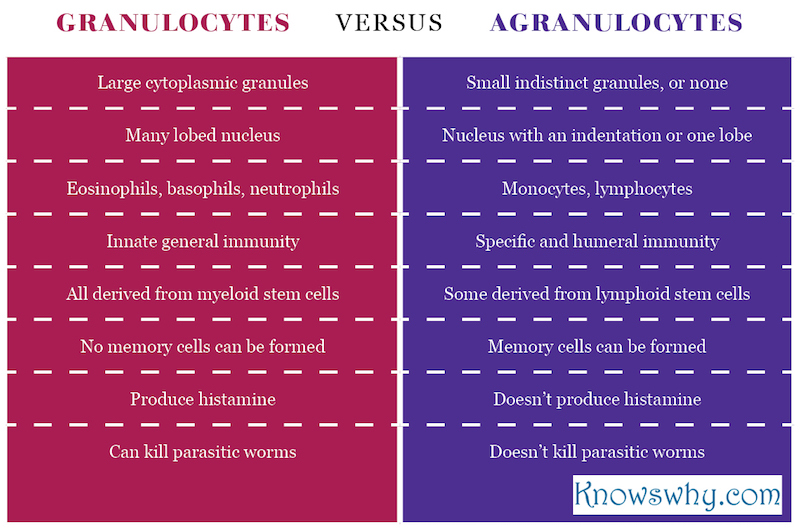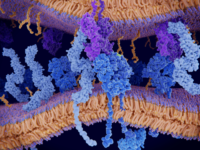
What is Granulocytes?
Granulocytes are a type of white blood cell (leucocyte) that has distinct, easily visible, large microscopic granules in the cytoplasm.
Granulocytes also have irregular shaped nuclei with more than one lobe.
- They form part of the innate immune system, and are the most abundant of all the leucocytes.
- Granulocytes provide a natural non-specific innate immunity, which is not in response to specific antigens.
- They are not effective against all invaders since some microbes are unable to undergo phagocytosis and, certain microbes may even destroy some leucocytes.
- Chemical signals from invading microbes or damaged tissues attract these cells to the site of injury or invasion.
- Thus granulocytes tend to increase in number when there is a bad infection.
- They live only a few days and originate from stem cells in the bone marrow and mature in the bone marrow.
- The granular sacs that are the visible granules contain the enzyme lysozyme, which is used to digest foreign particles.
- The 3 types of granulocytes produced from myeloblasts in the bone marrow are: eosinophils, basophils and neutrophils.
- The granules of the 3 cell types stain differently. Granules of eosinophils stain red-orange, basophils stain blue or purple and neutrophils stain lilac.
- Eosinophils contain coarse granules, have a nucleus with 2 to 3 lobes and are often abundant in allergic reactions
- Eosinophils contain antihistamines and toxins that kill parasitic worms.
- They can perform phagocytosis especially on cells which have been marked with antibodies.
- Basophils have a 2 lobed nucleus, release histamine which increases blood flow and enables neutrophils to move into the area, and they also produce heparin.
- They intensify the inflammatory response, and are the least common of the granulocytes.
- Neutrophils are polymorphonuclear, having a divided nucleus with 2 to 5 lobes.
- These cells function in the phagocytosis of bacteria and foreign entities.
- Neutrophil cells increase in number in times of inflammation and infection, are the most abundant leucocytes and the first to respond to a threat.
What is Agranulocytes?
Agranulocytes are leucocytes that have few, not easily visible, granules in the cytoplasm.
They are monomorphonuclear, having a nucleus that is not lobed or at the most having an indentation on one side.
- They function in the specific immune response in which cells respond to specific chemicals.
- There are 2 types of agranulocytes: lymphocytes and monocytes.
- Lymphocytes have a large spherical nucleus, and have little cytoplasm in the cell.
- They identify foreign material and initiate the immune response, and constitute about 30% of all the white blood cells.
- Lymphocytes are the only cell produced from the lymphoblasts of the bone marrow and are the only cells to mature in the lymphoid tissues.
- Lymphocytes consist of B cells, T cells and natural killer cells, and have a specific response to invaders.
- Some B cells are known as plasma cells, and produce antibodies against invading organisms, this is humeral immunity.
- B cells produce antibodies in response to antigens on foreign cells.
- B cells mature in the bone marrow, while T cells mature in the thymus and physically attack and destroy invading entities and diseased cells.
- The T cells also secrete signals to communicate with other white blood cells thus helping activate the immune response.
- B and T cells can form memory cells, which are cells that having been exposed to a pathogen “remember” how to respond to it. These cells live for many years.
- Natural killer cells can recognize and destroy cancer cells and cells infected with a virus.
- Monocyte production is from monoblasts in the marrow.
- Monocytes differentiate into large phagocytic macrophages that have a large nucleus and abundant cytoplasm.
- Macrophages secrete chemicals that attract other leucocytes to the site of infection, and they also consume damaged cells.
What is the difference between Granulocytes and Agranulocytes?
- Granulocytes have obvious large granules in the cytoplasm while agranulocytes have none or very small indistinct granules.
- Agranulocytes have a nucleus with no lobe or with an indentation, while granulocytes have a nucleus with 2 or more lobes.
- Eosinophils, basophils and neutrophils are granulocytes, while lymphocytes and monocytes are agranulocytes.
- Granulocytes bring about an innate, general immune response while agranulocytes bring about a specific and humeral immune response.
- While all granulocytes are derived from myeloid stem cells, some agranulocytes are derived from lymphoid stem cells.
- Some agranulocytes can form memory cells that live a long time, while granulocytes can’t form memory cells and don’t live long.
- Granulocytes are responsible for producing histamines during an allergic response, while agranulocytes don’t produce histamines.
- Some granulocytes have chemicals that can kill parasitic worms while the agranulocytes don’t have such chemicals.
Table comparing Granulocytes and Agranulocytes

Summary:
- Granulocytes and agranulocytes are both leucocytes (white blood cells).
- Granulocytes contain distinct granules in the cytoplasm while agranulocytes contain only a few small granules or none at all.
- Granulocytes are polymorphonuclear (lobed nucleus), while agranulocytes aren’t polymorphonuclear.
- Granulocytes include eosinophils, basophils and neutrophils.
- Agranulocytes include monocytes and lymphocytes.
- Granulocytes provide general innate immunity while agranulocytes provide specific and humeral immunity in response to exposure to antigens.
- Eosinophils, basophils, neutrophils and monocytes are derived from myeloid stem cells in the bone marrow where they also mature.
- In contrast, lymphocytes originate from lymphoid stem cells and then mature in the thymus.
- T and B lymphocytes, can form memory cells that are long-lived, some granulocytes produce chemicals to kill parasitic worms and some produce histamines during an allergic reaction.
- Specific and innate immunity work together in the immune response.
Author: Dr. Rae Osborn
Dr. Rae Osborn holds Honours Bachelor of Science degrees in Zoology and Entomology, and Masters of Science in Entomology from the University of Natal in South Africa. She has received a PhD in Quantitative Biology from the University of Texas at Arlington. She was a tenured Associate Professor of Biology at Northwestern State University in Louisiana for 10 years. She also completed an AAS Degree in Information Network Specialist and an AAS in Computer Information Systems, at Bossier Parish Community College in Louisiana.











Leave a Reply